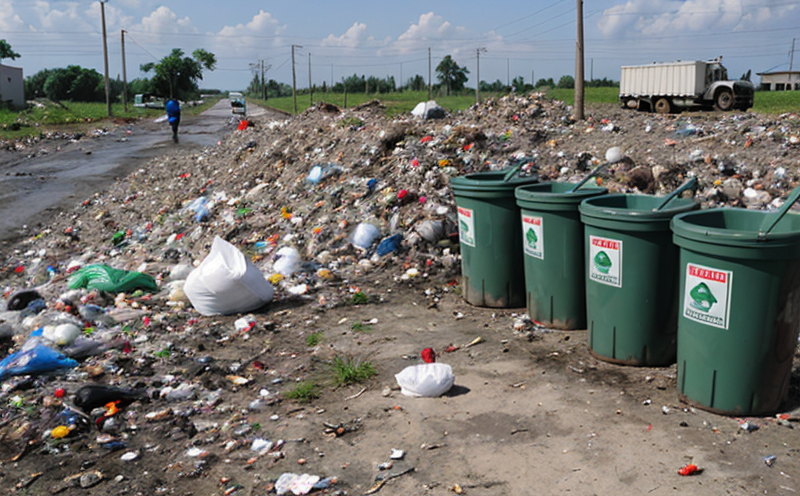ISO 16721 Digestion of Solid Waste Samples for Metals Test
The ISO 16721 digestion process is a critical analytical method used to determine trace metals in solid waste samples. This procedure allows laboratories to break down the complex matrix of solid materials, enabling accurate and reliable quantification of metal content. The test is widely recognized for its precision and repeatability, making it an indispensable tool for regulatory compliance and environmental research.
The digestion process involves the use of strong acids such as nitric acid (HNO₃) and perchloric acid (HClO₄) to dissolve organic materials in solid waste samples. This step is crucial because many metals are bound within complex organic compounds that cannot be easily accessed by analytical techniques without prior dissolution. Once digested, the sample becomes more amenable to metal analysis using techniques like Inductively Coupled Plasma Mass Spectrometry (ICP-MS) or Flame Atomic Absorption Spectroscopy (FAAS).
The ISO 16721 method is specifically designed for solid waste samples and ensures that all recoverable metals are released into solution. This makes it an ideal choice for industries dealing with hazardous waste, recycling operations, and environmental remediation projects. The digestions must be carried out under controlled conditions to ensure consistent results. It is important to note that the digestion process can also lead to volatilization of certain elements, particularly volatile metals like mercury (Hg) or cadmium (Cd), which require additional precautions.
The acceptance criteria for this test are stringent and align with international standards such as ISO 16721. Laboratories must demonstrate that their methods meet the specified limits of detection and quantification. Compliance with these standards is essential to ensure accurate results and reliable data reporting, which can be critical in regulatory contexts.
For industries involved in waste management, the ability to accurately determine metal content within solid waste samples is vital for compliance with environmental regulations. This includes the identification of hazardous materials that may require special handling or disposal methods. The ISO 16721 digestion process thus plays a pivotal role in ensuring that these regulatory requirements are met.
The digestion method also supports research and development efforts aimed at improving recycling processes and enhancing waste management practices. By providing precise data on metal content, this test can help identify valuable materials for recovery and minimize the environmental impact of waste disposal.
International Acceptance and Recognition
The ISO 16721 digestion process enjoys widespread acceptance across various industries and regions. It is recognized by regulatory bodies such as the European Union (EU) and the United States Environmental Protection Agency (US EPA). Compliance with this standard ensures that laboratories meet international quality standards, which is crucial for global trade in solid waste products.
The method’s recognition extends beyond just compliance; it also supports research and development activities. By adhering to ISO 16721 guidelines, researchers can ensure consistency and accuracy in their findings across different laboratory settings worldwide. This standardization fosters collaboration among scientists and engineers from diverse backgrounds, promoting the advancement of environmental science.
The adoption of this digestion process by international organizations highlights its importance not only for regulatory compliance but also as a benchmark for excellence in analytical chemistry. Laboratories that achieve certification according to ISO 16721 are held in high regard, enhancing their credibility and reputation within the scientific community.
Competitive Advantage and Market Impact
The adoption of ISO 16721 digestion processes offers several competitive advantages for laboratories operating in environmental testing. By providing accurate metal content analysis, these methods enable companies to stay ahead of regulatory changes and ensure compliance with ever-tightening environmental standards.
For quality managers and compliance officers, the ability to rely on consistent and precise results from ISO 16721 digestion ensures that their organizations meet legal requirements. This reduces the risk of penalties associated with non-compliance while also enhancing corporate reputation through responsible environmental stewardship.
In addition to regulatory compliance, the use of this method supports sustainable business practices by enabling more efficient waste management processes. By identifying valuable metals and other resources in solid waste streams, businesses can reduce costs related to waste disposal and improve overall sustainability metrics.
The competitive edge gained from using ISO 16721 digestion is particularly pronounced for companies engaged in recycling operations or those involved in environmental remediation projects. Accurate metal content data allows these organizations to optimize resource recovery efforts and minimize the release of harmful substances into the environment.
Use Cases and Application Examples
| Use Case | Description |
|---|---|
| Regulatory Compliance | Determining trace metal content in solid waste samples to ensure compliance with local and international regulations. |
| Hazardous Waste Management | Evaluating the presence of heavy metals in hazardous waste streams for proper classification and disposal. |
| Recycling Operations | Identifying valuable metals within solid waste streams to enhance resource recovery processes. |
| Environmental Remediation | Assessing the effectiveness of remediation efforts by monitoring metal concentrations in treated soil and water samples. |
| Hazardous Waste Classification | Determining the potential for leaching of metals from waste materials to inform disposal methods. |
| Research & Development | Supporting innovation in recycling technologies by providing accurate data on metal content and behavior. |
| Sustainable Resource Management | Evaluating the feasibility of resource recovery initiatives by assessing the concentration of valuable metals in waste streams. |
The ISO 16721 digestion process plays a crucial role across various sectors, from hazardous waste management to environmental remediation. By accurately determining metal content, this method supports regulatory compliance, enhances resource recovery efforts, and promotes sustainable business practices. Its wide-ranging applicability ensures its relevance in both regulated industries and cutting-edge research environments.





